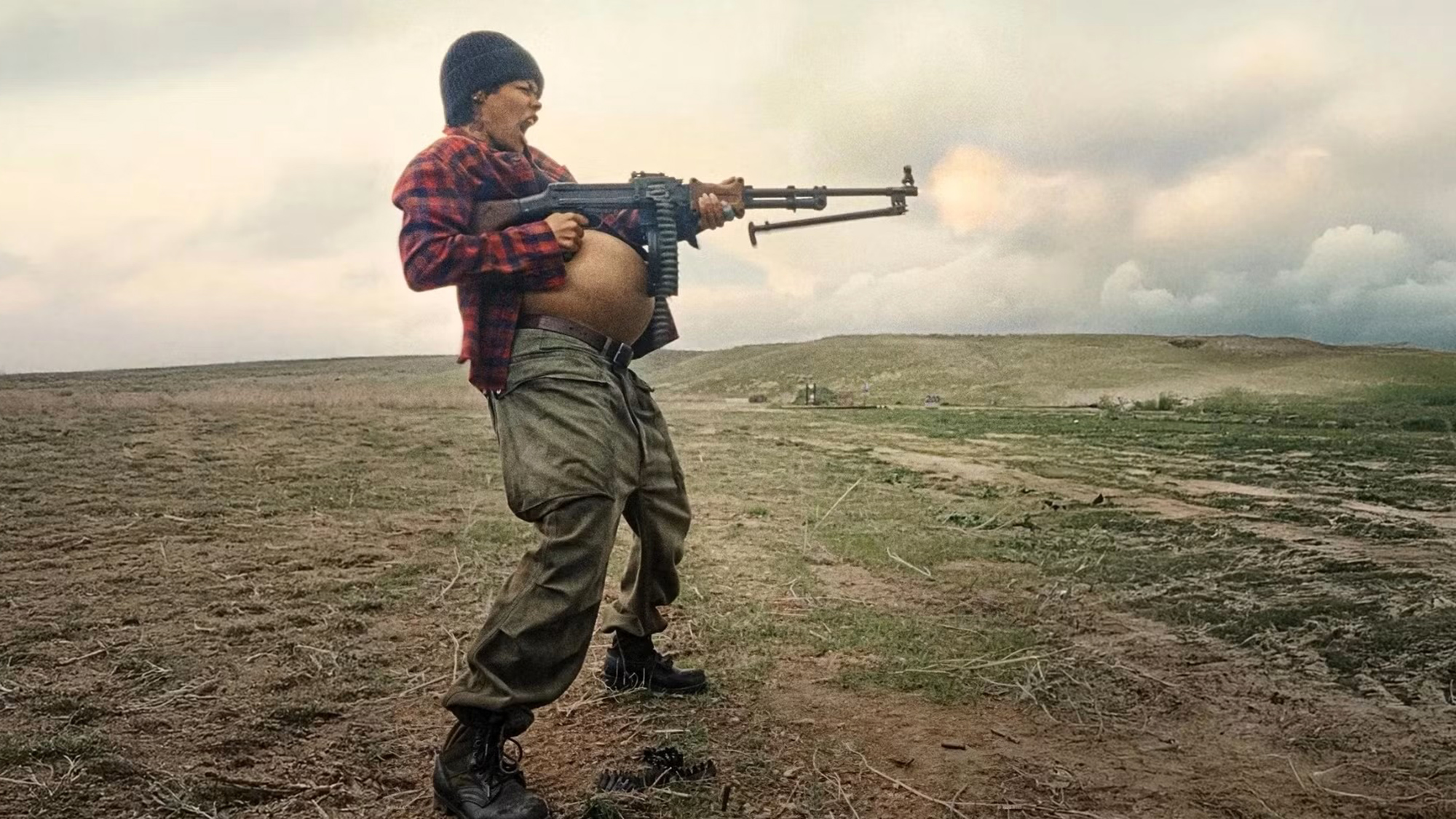Paul Thomas Anderson’s latest venture into the grandiose, the propulsive One Battle After Another, has been hailed as the most politically charged studio film in years. However, the film’s ambiguities seem to rebel against this notion. In this article, Jakob Freudendal unpacks the ambivalence at the core of the film while linking it to the director’s signature, and, in the process, confronting his own lingering disappointment with the no doubt impressively staged film.
Spoilers abound.
A major theme in the cinema of Paul Thomas Anderson is the struggle for control in a world caught in relentless pursuit of progress. His protagonists are often entitled men grappling with their own inconsequentiality, desperate to make their mark on history by dominating or rebelling against their environment. They establish surrogate families and/or cults, practice countercultural sentiments or dive into repression to attempt to control what is out of control. Motions to cede control to achieve a symbiotic relation with their surroundings frequently result in near-fatal self-poisoning. Indeed, Anderson’s characters nearly always learn the hard way that control is an illusion, as they are ultimately consumed by the forces they seek to master.
For Anderson, the fixation on control extends to the formal rigor of his opulent cinematic language. His pictures are grand and often utilize scope compositions and elaborate dolly and Steadicam shots. Coupled with impeccable needle drops or the lush orchestrations of Jonny Greenwood, Anderson stops at nothing to reach for the transcendent. The grandeur is not just apparent in his style. Thematically, he frequently connects the dark sides of the mind with wide-ranging state of the nation addresses on modern alienation and psychosexual frustrations.
His subjects are the generations laid to waste by the mechanisms of their country or left to reckon with the faults of previous generations. In fact, Anderson’s body of work could be read as one long critique of various stages in the process of consumer capitalism atomizing human connectivity and encroaching on the sanctity of culture – a development that allows some people to profit from the existential and spiritual emptiness of the modern world. These are the elements that have won Anderson many ardent followers and – although you must look hard to find them – equally passionate detractors. A frequent point of criticism is that Anderson falls short of reaching transcendence itself, because he labors so hard attempting to get there (e.g., Pinkerton 2017).
What then of Anderson’s latest venture into the grandiose, the propulsive One Battle After Another, which, at least on the surface, seems to relinquish the need for control that has defined its master? The film marks new territory for Anderson, while at the same time tracking a similar path to his previous works. Indeed, all the above trademarks are omnipresent – although by way of markedly different means than commonly deployed by the director.
Two sides of the same coin
Powered by loose inspiration from a Thomas Pynchon novel, spectacularly kinetic action set pieces and the wry satire and digressions that have come to define his later features, Anderson for the first time strives for multiplex entertainment while retaining his ambitions of dissecting the state of his country. So much so, in fact, that One Battle After Another can best be described as an admirable ghost in the machine in contemporary risk-and-politics-averse Hollywood.
This time, illusions of harnessing the chaos of the world are seemingly abandoned from the get-go. Instead, Anderson nosedives into the contradictions and historical continuity of the present, thereby stepping into the 21st century for the first time since Punch-Drunk Love (2002). Here, the characters’ only way to exert futile control is to either hit back against the system, one battle after another, or become part of the cults supposedly structuring the world from corner offices in corporate skyscrapers and country club basements.
The forward thrust of One Battle After Another is the twisted genealogical joke of revolutionary descendant Willa (Chase Infiniti) who discovers that she is not the biological daughter of revolutionary pothead Bob Ferguson (Leonardo DiCaprio) but descends from white supremacist Colonel Steven Lockjaw (Sean Penn), sublimating his repressed lust for black women into a quest for Aryan world dominion (fig. 2). Bob and Lockjaw are two opposing forces on a collision course. Yet Anderson makes a point of showing them as opposite sides of the same coin in their apparent failure to abide by the codes of the ideological cults that they inhabit. Indeed, a favorite motif of Anderson is to draw parallels between seemingly opposite forces, thus revealing their similarities.
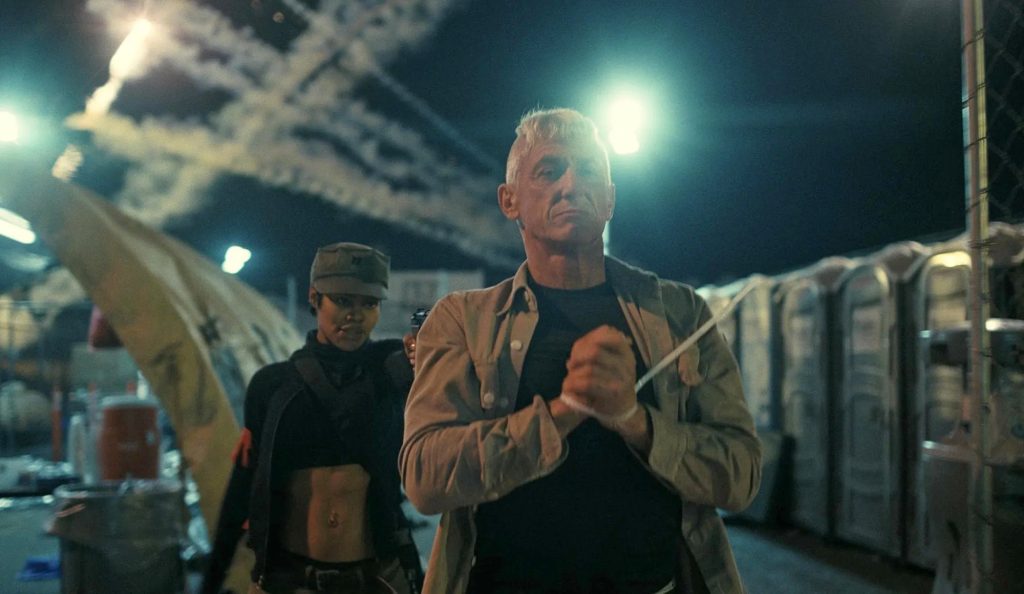
Through these parallels, Anderson shows how principles have eroded in favor of the murkiness of instincts and desire. The revolutionaries of the French 75, led by the enigmatic (and underused) Teyana Taylor as Perfidia Beverly Hills, proclaim to act on principles – “free borders, free choices, free from fear” – yet their actions are propelled by sexual drives, as when Perfidia and Bob kiss and have sex during acts of anti-state terrorism. Lockjaw’s politics are betrayed by his initial boner-turned-obsession that sends him spinning after Perfidia. And Perfidia’s powerplay with Lockjaw – and her ultimate betrayal of her comrades – suggests that perhaps she is not as devoted to the political cause, as she is to exerting psychosexual dominance.
White men’s follies on native ground
In this way, One Battle After Another does not easily conform to the ravings of the most politically charged studio film in decades. Rather, the film employs numerous strategies that undercut such easy connotations: Although several plot elements appear ripped from today’s headlines, such as immigrants held in cages in ICE-like detention centers, and US soldiers descending on national territory at will, the film is deliberately ambiguous about the specificities of the world and most of the organizations it sets forth: Rather than tackle the present head-on, Anderson suggests an eternal present of sorts with no clear demarcation of the exact time period.
It is a mirage world of underground tunnels and secret networks with shadow forces exerting their influence from the periphery of society – or from within the state itself. But the film underlines the vagueness of the French 75’s politics and keeps those they claim to fight for neatly out of view. It also obscures the organizational setup enabling the French 75 to undercut government activities, making it play more as fantasy than realism in contrast to, for instance, The Battle of Algiers (Pontecorvo, 1966), which the film references. In One Battle After Another, revolution is a fantasy without progress or a master plan. In contrast, the politics and organizational layout of the Christmas Adventurer’s Club are perfectly crystallized, and seemingly much closer to current reality. The white supremacists are the real actors, while the revolutionaries are fantasy objects simply reacting to the former’s actions. Yet despite this transparency, the caricature with which these white supremacists are portrayed inhibits the impact of this troubling truth.
The film’s central thesis – as referenced in the title – is that the US is defined by the long lineage of cyclical violence that trail these ideological poles. The loop is alluded to numerous times throughout the film: From Bob’s critique of his daughter’s history teacher and her parading of colonialist former US presidents in the classroom to the crucial scene of the native American bounty hunter who seemingly recognizes himself, and the violence committed to his people, in Willa, thereby deciding to save her, only to be punished for it. These elements gain a broader significance through the film’s western connotations and its dedication to exploring the acts of defiance through the lens of useless white men perpetrating their follies on native ground as the root of the cyclical status quo.
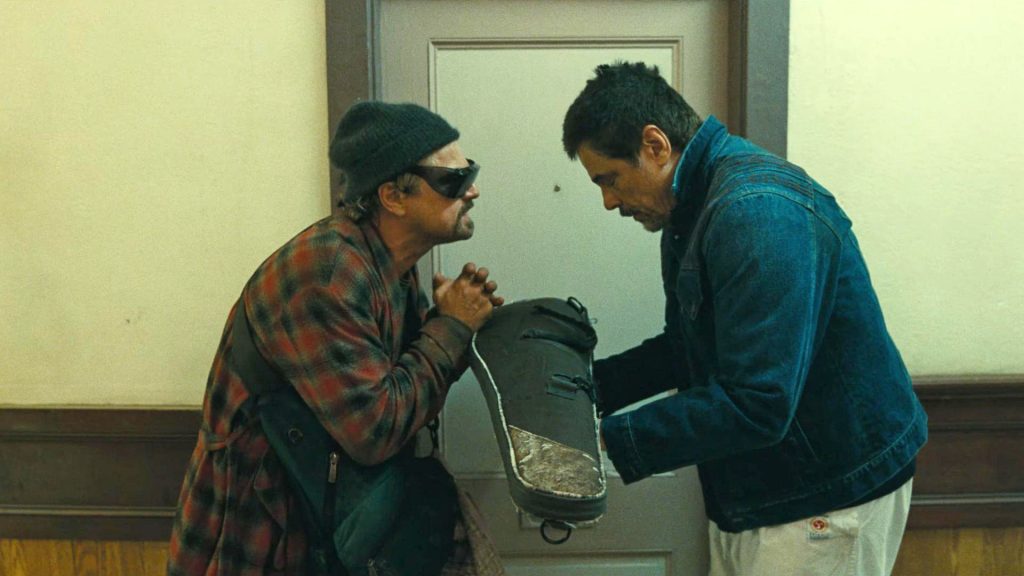
Benicio del Toro’s character Sensei Sergio St. Carlos (fig. 3) embodies this most of all: He is casually swept up in a futile revolution, which is not really a revolution but the quest of a desperate idiot to save his daughter. This is clearly not Sensei’s fight, yet he lends Bob his people’s resilience from 100+ years of fighting the system (the real revolution). Sensei is a bystander caught up in the actions of the white men, a classic western trope. The white men’s quest for their daughter – who is trying to escape both her spiritual and biological fathers – might, in this way, also be deserving of comparisons to The Searchers (Ford, 1956), in which John Wayne similarly attempts to harness a female relative on the run.
Overlapping frictions
The cyclical loop of history is further ingrained in the narrative structure of One Battle After Another. When explosive expert Ferguson early in the movie explains how he is creating a “closed circuit”, this line divulges the film’s cyclical structure, where ideological clashes are perpetuated into eternity. The “time doesn’t exist, yet it controls us anyway” line seems to allude to this struggle. However, for much of its runtime, One Battle After Another seems to track the forward motion of the chase film. This produces an interesting friction, as the circular overlaps with the linear – culminating in the film’s final bravura set piece where Anderson adds another plane of motion to the collision of the linear and circular:
The two fathers’ pursuit of Willa climaxes in an extended car chase, where four vehicles race up and down the slopes of a Californian desert highway (fig. 4). It is a cinematic theme park ride that proves Martin Scorsese’s Marvel comparison wrong: Cinema can, apparently, resemble a roller coaster ride without compromising its integrity. In this sequence, the horizontal, linear movement of the chase overlaps with the vertical up-and-down movement, where the characters are literally unable to see what’s ahead of them (a startling image of a nation driving towards its own demise blindfolded). At the same time, the scene superimposes the perpetuating circular motion, as Bob must turn back after initially following the wrong car. In the meantime, his daughter takes care of business herself, thus leaving Bob to accomplish exactly nothing for the entire runtime of the film, underlining the many facets of the character’s impotence.
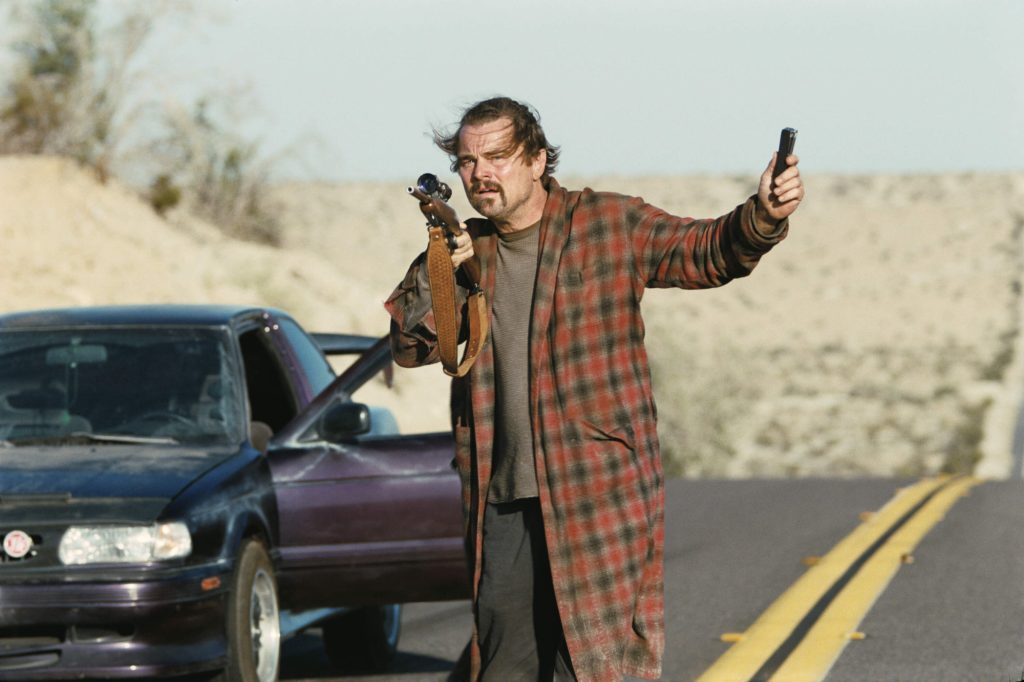
Much of the film’s political ambiguity stems from the collision of linear and circular structures. On the one hand, the linear movement suggests progress, as new generations right the wrongs of their predecessors. Certainly, this can be implied from the ending, in which Willa rises to fight another battle, perhaps learning from the mistakes of her father(s) by mastering the code he was unable to articulate. Thus, she fulfills the revolutionary lineage of her mother, while rejecting that of her biological father – perhaps even using her mixed gene pool to bridge these opposing forces, a proposal the film doesn’t fully mobilize in its nurture vs. nature dichotomy. On the other hand, the circular motion seems to suggest that Willa is ultimately doomed to repeat the same mistakes of Bob’s generation, rehearsing the same ideological codes that the film has dedicated its runtime to caricaturing. Doomed to lose the same battles, because the powerful white supremacist forces at the root of the film’s plot are ultimately left unscathed.
Indeed, the film’s final blow to Bob’s couch potato revolutionary – a man more in love with the fantasy of revolution than the reality – suggests the fallacy of revolutionary ideals. Here, Bob’s only successful act of defiance – the refusal to own a smartphone – is stripped, as he succumbs to the commodified powers of big tech by purchasing an iPhone (see also Ari Aster’s Eddington (2025) for a much more aggravating use of the same punchline). Of course, the ambiguous entanglements of optimism and pessimism certainly could be seen as the most accurate depiction of the present and its ideological hollowness. However, it also seems to perpetuate some of Anderson’s misanthropic tendencies, as the title also alludes to the general worldview that has pervaded many of his films: Life as a continuous battle of strained humanity.
Auteurist perfection?
In a film hailed for being gloves off and speaking truth to power, it seems odd that One Battle After Another is dedicated to promoting the seeming futility of human action. While in no way blurring its anti-authoritarian allegiances, One Battle After Another ridicules both sides of the ideological fence. Maybe this is precisely the quality that will set the film apart. Yet, for me, the ensuing ambivalence frequently felt overly constructed, eliding what could have been a forceful depiction of the present by instead favoring fantasy and cartoonish satire. Despite all the chaos Anderson conjures in his vision of two men grappling with the tough realities of their respective desires, the film’s chaos ultimately remains subordinate to the rushed narrative, which reduces the uncontrollable state of the present to an insular father-daughter-conflict (fig. 5). Politics are deployed mainly as plot mechanisms or mined for laughs, as if afraid to really interrogate the complexities of its subject matter. If this is ultimately slightly disappointing, it may be linked to the overwhelming appraisal of the film as political cinema – a statement that the film itself seems to rebel against, which makes its use of modern-day politics as plot vehicle borderline gratuitous.
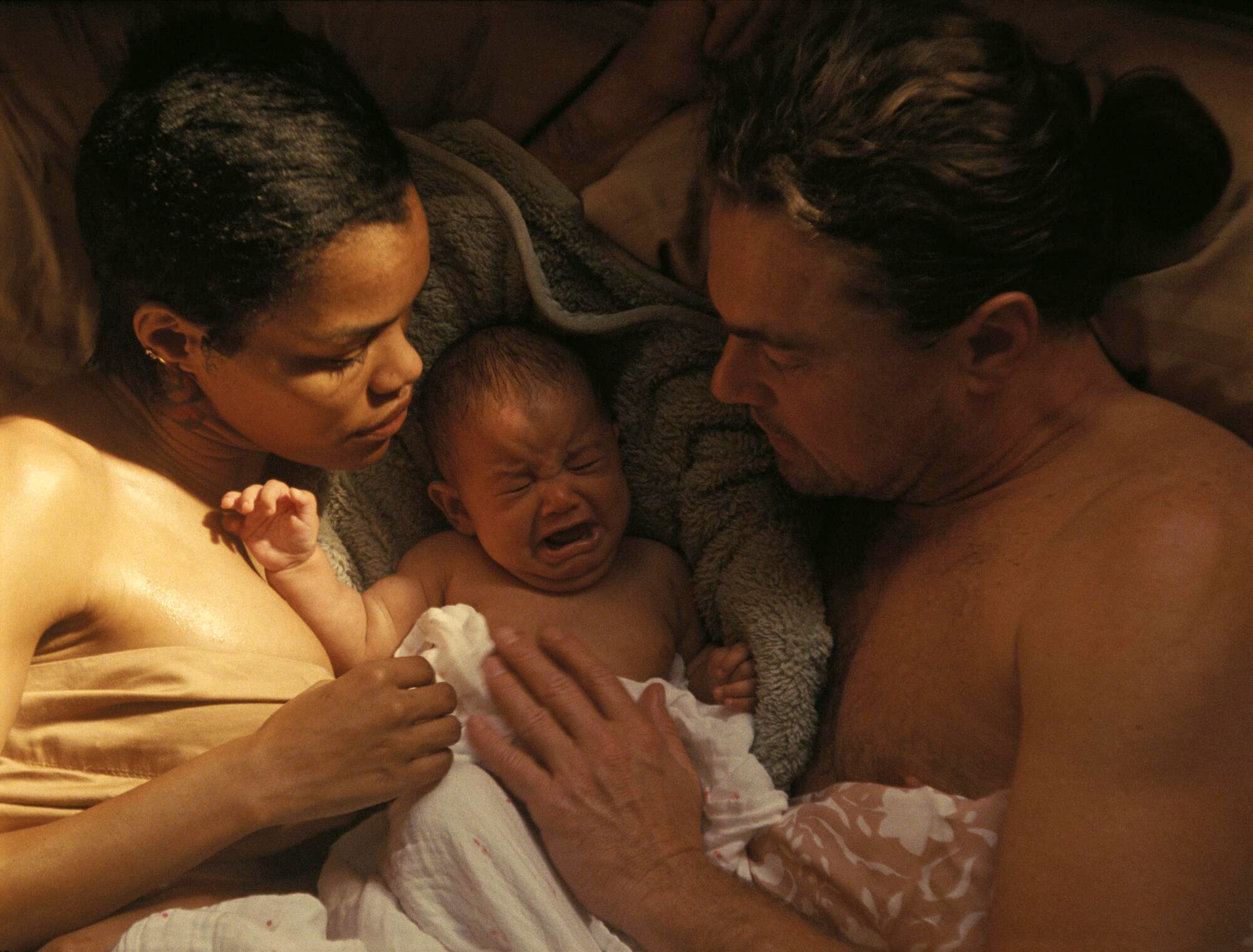
When Steven Spielberg, prior to the film’s release, heralded One Battle After Another as the closest companion to Kubrick’s Dr. Strangelove (1964), it seemed like Anderson’s journey towards auteurist perfection had been completed. After all, he is a filmmaker who customarily wears his references on his sleeves. He has moved through Scorsese, Altman and Demme – sometimes hyperbolically incorporating them all at once – before finally settling on the humblest of inspirations: Stanley Kubrick, the arguably most celebrated master of cinema whom Anderson visited on set for his final masterwork Eyes Wide Shut (1999). But while Anderson’s cinematic grandeur may match that of Kubrick, he rarely achieves the same transcendence regarding themes and characters, and with One Battle After Another he does not quite reach the same forceful lament suffused in the unhinged, but very palpable, madness of Dr. Strangelove.
Some of these shortcomings can perhaps be ascribed to the fast-forward montage nature of the prologue. That sequence is the building block for all ensuing action, yet the characters are so sparsely parsed that they hardly register beyond generics. Likewise, the central father-daughter relation asks us to fill in the gaps based on just a few scenes that struggle to establish them as human beings of flesh and blood. The character of Willa is especially sidelined here, as her development story is supposedly the heart of the film, yet she remains awkwardly at the periphery of DiCaprio’s (non-)action. To be sure, the film also transposes the perennial Anderson motif exploring the fear of growing up to the more mature parental fear of watching your kids grow into a chaotic world. Yet I couldn’t escape the feeling that Anderson does not fully sustain these emotions in his own scenes. As a result, the film evokes other, superior works that each explore only one aspect of One Battle After Another’s kaleidoscopic story, rather than brushing over them all without interrogating them in depth.
I was reminded of a host of references that Anderson evokes: From the Heat (Mann, 1995) allusions of the fast forward-styled prologue (including one of the most desperate getaway drives since Michael Mann’s masterpiece). The post-counterculture hangover of Running on Empty (Lumet, 1988), depicting the child’s toils of living in the shadows of their parents’ acts of left-wing terrorism. The similarities to Kelly Reichardt’s (much more contained) The Mastermind (2025), in which a slacker feels entitled to leave his mark on (art) history only to discover how out of touch with the present he really is. Unfortunately, One Battle After Another most resembles Eddington, though Anderson crucially manages to find empathy for his characters while ridiculing them – even if he nearly betrays that empathy in the miscalculated Lockjaw finale. The cyclical status quo of ideology seems to be the film’s ultimate point, but I am not entirely convinced that it achieves its subversion to the same extent that Eyes Wide Shut, for instance, does (an unfair comparison for any film to live up to).
“The revolution will not be televised, the revolution will be live”, says Gil-Scott Heron, as the credits roll, yet I left the cinema with the feeling that Anderson both celebrates and betrays those words. Maybe this is the entire point, but to me, he seemed perfectly comfortable televising a revolution from the controllable distance of caricature, without truly getting his hands dirty.

Facts
- One Battle After Another. Dir. Paul Thomas Anderson. Ghoulardi Film Company et al., 2025. Currently screening in cinemas.
Films
- La battaglia di Algeri. Dir. Gillo Pontecorvo. Igor Film et al., 1966.
- Dr. Strangelove or: How I Learned to Stop Worrying and Love the Bomb. Dir. Stanley Kubrick. Stanley Kubrick Productions, Columbia Pictures Corporation, 1964.
- Eddington. Dir. Ari Aster. A24 et al., 2025.
- Eyes Wide Shut. Dir. Stanley Kubrick. Warner Bros. et al., 1999.
- Heat. Dir. Michael Mann. Warner Bros. et al., 1995.
- The Mastermind. Dir. Kelly Reichardt. Film Science, Mubi, 2025.
- The Searchers. Dir. John Ford. C. V. Whitney Pictures, 1956.
- One Battle After Another. Dir. Paul Thomas Anderson. Ghoulardi Film Company et al., 2025.
- Punch-Drunk Love. Dir. Paul Thomas Anderson. New Line Cinema et al., 2002.
- Running on Empty. Dir. Sidney Lumet. Double Play, Lorimar Film Entertainment, 1988.
References
- Pinkerton, N. (2017). ‘The Master? Paul Thomas Anderson as American Auteur’. The Point. Accessed 6 October 2025.

